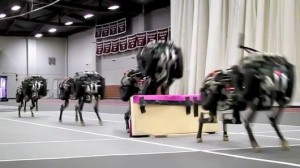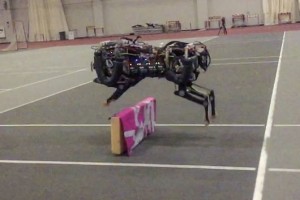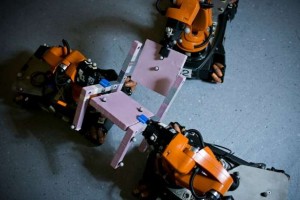MIT’s robotic cheetah can now leap over obstacles
The last time we heard from the researchers working on MIT’s robotic cheetah project, they had untethered their machine to let it bound freely across the campus lawns. Wireless and with a new spring in its step, the robot hit speeds of 10 mph (6 km/h) and could jump 13 in (33 cm) into the air. The quadrupedal robot has now been given another upgrade in the form of a LIDAR system and special algorithms, allowing it to detect and leap over obstacles in its path.
MIT’s robotic cheetah project has been in the works for a few years now. The team’s view is that the efficiency with which Earth’s fastest animal goes about its business holds many lessons for the world of robotic engineering. This line of thinking has inspired other like-minded projects, with DARPA and Boston Dynamics both working on robotic cheetahs of their own.
The MIT team says it has now trained the first four-legged robot capable of jumping over hurdles autonomously as it runs. With an onboard LIDAR system, the machine is now able use reflections from a laser to map the terrain. This data is partnered with a special algorithm to dictate the robot’s next moves.
The first part of this algorithm sees the robot identify an upcoming obstacle, and determine both its size and the distance to it. The second part of the algorithm is what enables the robot to manage its approach, determining the best position from which to jump and safely make it over the top. This sees the robot’s stride adjusted if need be, speeding up or slowing down to take off from the ideal launch point. This algorithm works in around 100 milliseconds and is run on the fly, dynamically tuning the robots approach with every step.
Right as the robot goes to leave the ground, a third part of the algorithm helps it work out the optimal jumping trajectory. This involves taking the obstacle height and speed of approach to calculate how much force is required from its electric motors to propel it up and over the hurdle.
Putting the cheetah’s new capabilities to the test, the team first set it down to run on a treadmill while tethered. Running at an average speed of 5 mph (8 km/h), the robot was able to clear obstacles up to 18 in (45 cm) with a success rate of around 70 percent. The cheetah was then unleashed onto an indoor test track, running freely with more space and longer approach times to prepare its jumps, clearing about 90 percent of obstacles.
“A running jump is a truly dynamic behavior,” says Sangbae Kim, assistant professor of mechanical engineering at MIT. “You have to manage balance and energy, and be able to handle impact after landing. Our robot is specifically designed for those highly dynamic behaviors.”
Kim and his team will now look to improve the robot further so that it can leap over obstacles on softer terrain such as grass. They will demonstrate the cheetah’s new capabilities at the DARPA Robotics Challenge in June. Gizmag will be trackside to bring you a closer look.
References:http://www.gizmag.com/





